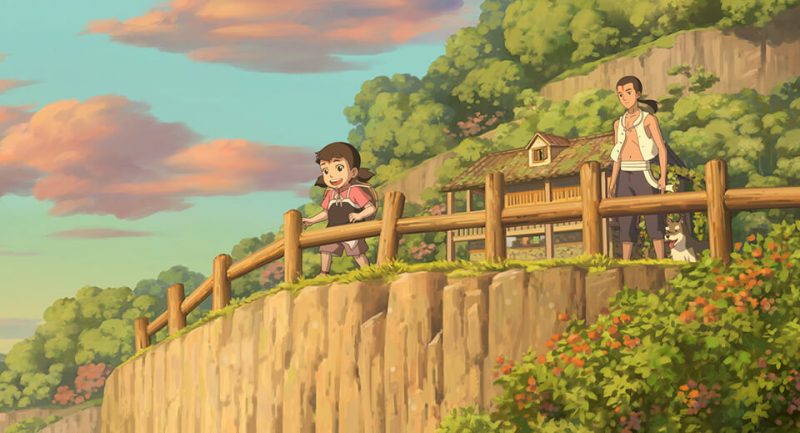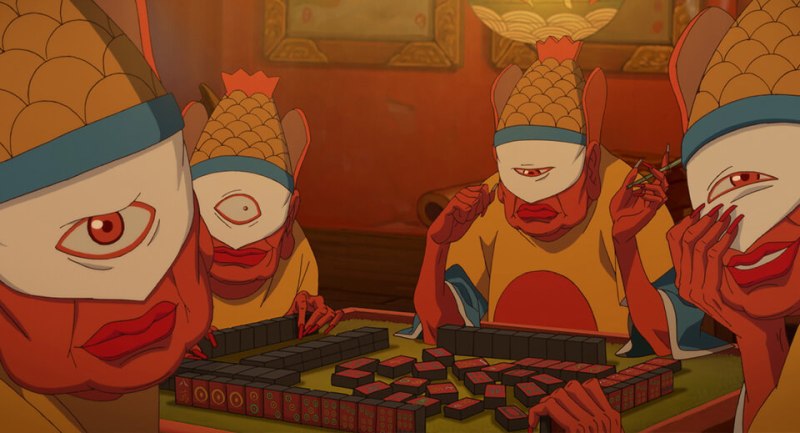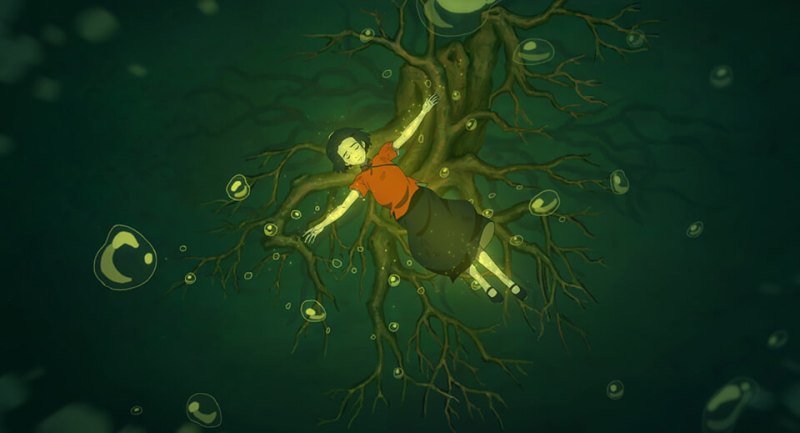Released in China on July 8, 2020, Liang Xuan and Zhang Chun’s long-gestating animation feature has finally arrived in North America. Highly anticipated in its native China and scoring big at the box office, Big Fish & Begonia has been garnering little fanfare over here, but it deserves a larger audience. The film is a unique and singular work of animation, an enthralling adventure story that succeeds despite some narrative shortcomings and potential cultural barriers.
Big Fish & Begonia tells the story of Chun, an inhabitant of a mystical realm, who is about to enter adulthood by participating in a ritual journey to the human realm. On this journey, she encounters Kun, a young fisherman from a small village. During a storm, Chun—who has taken the form of a dolphin—gets trapped in a net and inadvertently causes Kun to drown when he comes to her rescue. Wracked with guilt and hoping to repay Kun, Chun returns home and makes a bargain with the Soul Keeper to retrieve Kun’s soul and return him to the human realm. This is just the beginning of a much larger and more perilous journey.

The journey is exciting but admittedly uneven. The opening segments are deliberately paced, going a long way to establish atmosphere and tone but perhaps too unhurried when it comes to moving the plot. Once the journey is well underway, plot twists and developments quickly pile up, often overwhelming and cluttering the narrative. The structure of the film is a little too loose in the first half and a little too haphazard in the latter. Some scenes end abruptly or feel incomplete, lacking internal rhythm. One particularly interesting subplot—involving a sewer-dwelling Rat Matron who tends to the souls of sinners—is ultimately left dangling. The Rat Matron provides a contrast to the Soul Keeper, performing a similar function (both have unique roles in the ferrying of souls and provide assistance to our heroes with potentially dangerous costs), but with vastly different motivations. Her sudden appearance at a pivotal plot moment is simply a contrivance to prevent our heroes from achieving their goals and prolong the journey; her departure has broad and potentially dire implications for the human world, but the film decides to ignore them and promptly forgets this character ever existed.
Despite these narrative shortcomings, the film is a spellbinding work of animation. The world of Big Fish & Begonia is realized with a large and gorgeous color palette, and richly detailed backdrops that are often stunning and breathtaking. The animation itself is clean and fluid, owing in no small part to the contributions of Studio Mir (if that name rings a bell, it’s probably because of their work on the popular Nickelodeon series, The Legend of Korra). The film also boasts a wonderful musical score, the best one I have heard so far this year, courtesy of composer Yoshida Kiyoshi (most famous perhaps for composing the score for Hosoda Mamoru’s The Girl Who Leapt Through Time).

A big part of the appeal of Big Fish & Begonia is its cultural specificity, with its visual designs and story rooted in Chinese myth and legend; it’s a novelty in a field otherwise dominated in the collective consciousness by Japanese animation (it is unsurprising, but also unfair, that the film has repeatedly drawn comparisons to Studio Ghibli). The film also assumes a Chinese audience, however, so that specificity could also be a barrier. The stories and myths that Liang Xuan and Zhang Chun draw upon might be familiar to the movie-going public in China, but unfamiliar to a Western audience, rendering elements of the narrative obscure or confusing. The distributor, Funimation, seemingly anticipated a niche appeal; the film was only given limited engagements in various American cities, and in Canada, the subtitled and dubbed versions were each given a single screening, as part of the Cineplex Events program, instead of a theatrical release. This is a stark contrast to the popularity of last year’s domestic release of Your Name, which saw a lot of repeat weeks in Toronto, or the popularity of Japanese animation in this market in general.

Chun’s journey is about the value of each individual life and fighting for what you believe is right. Moreover, it is a journey about responsibility and self-sacrifice. These broader themes provide an accessible avenue into the film’s deeper world and specific cultural background, and should help the film find a larger international audience. Big Fish & Begonia is a flawed film, stumbling through some story structure and pacing problems, but it’s also admirable in its ambitions and largely successful in realizing its artistic vision. It’s an easy recommendation for animation fans, but on the strength of its aesthetics, the wonderful music and richly detailed world, and the epic scale of its adventure, it’s worth a look by anyone.
